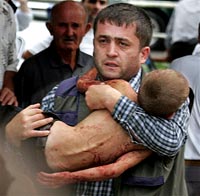Beslan secret video leaks to undermine reputation of Russia's security forces
A video that remained secret for nearly three years after the horrific Beslan hostage crisis has cast new doubt on official conclusions about what led to the deaths of more than 330 people - more than half of them children - during one of Russia's worst terrorist attacks.

The video is far from definitive about one of the central questions surrounding the Sept. 1-3, 2004, attack - what caused the initial explosions that were followed by a chaotic gunbattle and the collapse of the roof of School No. 1's gymnasium, where the more than 1,100 hostages were held.
A final official report of the events still has not been released. The lead parliamentary investigator, meanwhile, has suggested that the homemade bombs rigged up by the 32 heavily armed militants in the gymnasium were detonated by the militants, and that was the primary reason for the large death toll.
However, activist groups comprising victims and relatives of the dead, and at least one member of the parliamentary commission, maintain that law enforcement agencies botched the rescue operation, using flame-throwers, grenade launchers and heavy guns that worsened the situation. Dozens of survivors insist the explosions that sparked the maelstrom came from outside the building.
Susanna Dudiyeva, who heads the Beslan Mothers' Committee and was herself a hostage, accused the Federal Security Service, or FSB - Russia's primary security agency - of withholding crucial evidence.
"The FSB is giving up none of its own secret video material, which should have been turned over to investigators as evidence," she said. "Not one FSB agent has been interrogated. We have access to not one part of the documentary or video material or information."
"The investigation is at a dead-end," she said.
The video footage was shot with a hand-held camera and has a time-stamp from the moment on the afternoon of Sept. 3 when the first of two large explosions erupted. A cloud of smoke billows from near the building and gunfire can be heard.
Footage time-stamped several hours later shows several of the homemade explosive devices on a table. The devices, which had been hung from basketball hoops and the roof of the gymnasium, were plastic bottles filled with shrapnel and ball-bearings. In the gymnasium, several were rigged with a foot-trigger.
Two men, who are not shown, are heard talking. They appear to be bomb experts, and the Kommersant newspaper said they were army engineers being questioned by prosecutors.
"The holes inside (on the walls) could not have been caused by these explosives," one of the men says.
"If the explosions had been caused by these devices from inside the building..." he continues.
"Look at the ball-bearings," the second interrupts.
"...as they keep saying, all of these (ball-bearings) would have been scattered around but on the children we brought out (of the school) there was no evidence of these sorts of injuries. And all around too," the first man then says.
"So there was no explosion inside the building?" a third man asks.
"Inside the building, there was no explosion," the first man answers.
The video, parts of which were obtained by The Associated Press, was shown to some survivors and relatives of victims in Beslan last week and some fragments have been posted on Russian newspaper Web sites. Activists said law enforcement agencies confiscated many copies from them in North Ossetia, the region where Beslan is located.
One fragment posted by the liberal newspaper Novaya Gazeta is from Sept. 4 - the day after the siege ended - and shows an investigator surveying the school's courtyard. Bodies can be seen being put into black morgue bags. Another scene shows used grenade launchers lined up on the ground, though it was unclear to whom the weapons may have belonged.
Regional prosecutors did not answer phones Tuesday and federal prosecutors refused comment.
Last December, Alexander Torshin, the chairman of the parliamentary commission set up to investigate the attack, summarized what he said was a final version of his commission' report before the lower house of parliament.
Torshin laid blame for the seizure on local law enforcement, who he said did not follow orders from Moscow to increase school security ahead of the start of the new school year. He said the explosion precipitating the bloodshed was a bomb set off by the terrorists.
He also said there was no firm evidence that tanks had opened fire on the building while hostages were inside - contradicting accounts by eyewitnesses, including by The Associated Press.
Torshin was on vacation and unreachable on Tuesday, his spokeswoman said.
Yuri Savelyev, a lawmaker who was part of the Torshin commission, said he had not seen the video, but people had described it to him.
He said it appeared to confirm his own conclusions, which dissented from the Torshin report and found that grenade-launchers and gunfire from outside the school had sparked the explosions and the fire that brought down the gymnasium roof.
"There's nothing new in any of this," he said. "The fighters did not blow up the hall."
He speculated that the video - which activists said was sent to them anonymously by mail - had been leaked as a political tool, perhaps as a means to force personnel changes among federal security agencies, prosecutors or law enforcement officials.
Independent military analyst Alexander Golts said the video highlighted anew the "total and absolute failure of security service" during the seizure.
"It's absolutely clear that authorities don't want to hear any alternative version of assault in Beslan," he said.
Only one of the militants who seized the school survived. Nur-Pashi Kulayev was convicted last year and sentenced to life in prison.
A total of 334 people died either during or as a result of the attack.
Subscribe to Pravda.Ru Telegram channel, Facebook, RSS!


